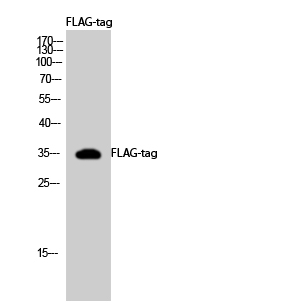DDDDK-Tag(binds to flag sequnence) rabbit pAb
- Catalog No.:YG0004
- Applications:WB;ELISA;IP;IF
- Reactivity:Species independent
- Target:
- FLAG-tag
- Gene Name:
- Flag tag; Flag-tag,DDDDK TAG, DDDDK-TAG, DYKDDDDK tag,DYKDDDDK-tag
- Immunogen:
- DDDDK synthetic peptide conjugated to KLH.
- Specificity:
- FLAG-tag Polyclonal Antibody detects FLAG-tagged recombinant proteins or FLAG-tagged proteins overexpressed in cells.
- Formulation:
- Liquid in PBS containing 50% glycerol, 0.5% BSA and 0.02% sodium azide.
- Source:
- Polyclonal, Rabbit,IgG
- Dilution:
- WB 1:1000 - 1:3000. ELISA: 1:5000-20000.. IF 1:50-200
- Purification:
- The antibody was affinity-purified from rabbit antiserum by affinity-chromatography using epitope-specific immunogen.
- Concentration:
- 1 mg/ml
- Storage Stability:
- -15°C to -25°C/1 year(Do not lower than -25°C)
- Other Name:
- DDDDK epitope tag;DDDDK epitope tag;DYKDDDDK epitope tag
- Background:
- The DYKDDDDK (FLAG) peptide has been used extensively as a general tag in expression vectors. This peptide can be expressed and detected with the protein of interest as an amino-terminal or carboxy-terminal fusion. N-terminal FLAG vectors provide an Ek cleavage site for removal of the fusion tag. The FLAG peptide is likely to be located on the surface of a fusion protein because of its hydrophilic nature. As a result, the FLAG peptide is more likely to be accessible to antibodies. A FLAG-tag can be used in many different assays that require recognition by an antibody, such as western blotting, immunocytochemistry, immunoprecipitation, flow cytometry, protein purification, and in the study of protein-protein interactions, cell ultrastructure, and protein localization and so on.
Positive feedback loop of YB-1 interacting with Smad2 promotes liver fibrosis. BIOCHEMICAL AND BIOPHYSICAL RESEARCH COMMUNICATIONS Biochem Bioph Res Co. 2017 Mar;484:753 WB Human LX-2 cell,293T cell
Pathogenic variants of meiotic double strand break (DSB) formation genes PRDM9 and ANKRD31 in premature ovarian insufficiency. GENETICS IN MEDICINE Genet Med. 2021 Jul;23(12):2309-2315 WB,IHC Human HEK293 cell
Impaired CBS-H2S signaling axis contributes to MPTP-induced neurodegeneration in a mouse model of Parkinson’s disease. BRAIN BEHAVIOR AND IMMUNITY Brain Behav Immun. 2018 Jan;67:77 WB Mouse striatum
The role of p21-activated kinase 4 in the progression of oral squamous cell carcinoma by targeting PI3K–AKT signaling pathway Clinical & Translational Oncology Fayu Liu WB Human oral squamous carcinoma cell
- June 19-2018
- WESTERN IMMUNOBLOTTING PROTOCOL
- June 19-2018
- IMMUNOHISTOCHEMISTRY-PARAFFIN PROTOCOL
- June 19-2018
- IMMUNOFLUORESCENCE PROTOCOL
- September 08-2020
- FLOW-CYTOMEYRT-PROTOCOL
- May 20-2022
- Cell-Based ELISA│解您多样本WB检测之困扰
- July 13-2018
- CELL-BASED-ELISA-PROTOCOL-FOR-ACETYL-PROTEIN
- July 13-2018
- CELL-BASED-ELISA-PROTOCOL-FOR-PHOSPHO-PROTEIN
- July 13-2018
- Antibody-FAQs
- Products Images

- Western Blot analysis using FLAG-tag Polyclonal Antibody against HEK293 cells transfected with vector overexpressing FLAG tag (1) and untransfected (2). Secondary antibody(catalog#:RS0002) was diluted at 1:20000



